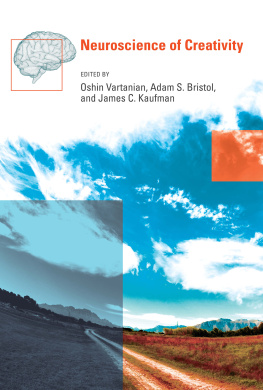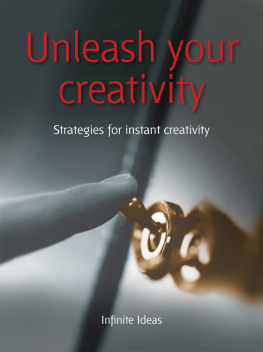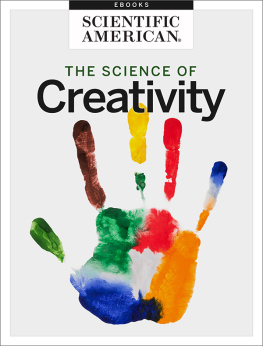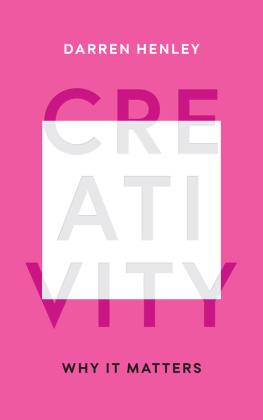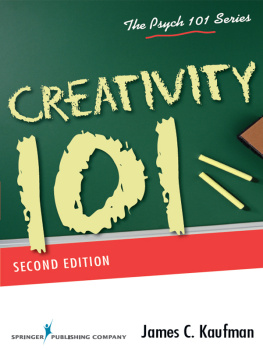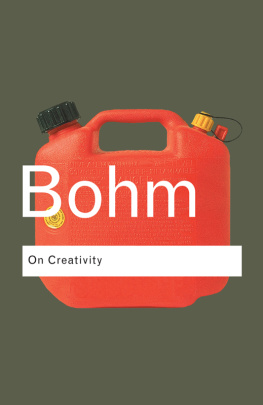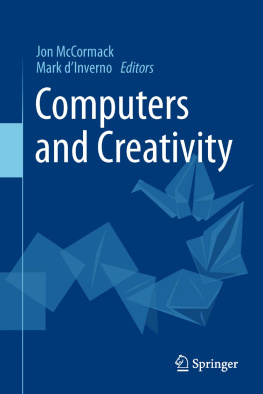Acknowledgments
The authors would like to thank Katie Persons, Judith Feldmann, and Phil Laughlin of the MIT Press for making this process so smooth and simple.
Oshins work on cognitive training is partly supported by an Applied Research Project funded by Canadas Department of National Defence.
Adam would like to thank Marc Schneidman for his mentorship and for his encouragement of intellectual curiosity among his coworkers. He would also like to thank Indre Viskontas for her unwavering support and guidance.
James would like to thank the people at CSUSB who make his work possibleincluding (former) President Al Karnig, Provost Andrew Bodman, Dean Jamal Nassar, Chair Robert Ricco, (former) Chair Robert Cramer, Mark Agars, Stacy Brooks, Stephanie Loera, Amanda Ferguson, and the Kaufman Inner Lab Leaders. And, always, Allison.
Introduction
Adam S. Bristol, Oshin Vartanian, and James C. Kaufman
Yet the suns that light the corridors of the universe,
shine dim before the blazing of a single thought.
So proclaims the intrepid Dr. Duval in the 1966 sci-fi film Fantastic Voyage, in which a group of scientists miniaturize themselves and enter the brain of a dying patient in search of a cure. What they find is a magical world of unanticipated complexity in an organ that continues to astound its master and servantanimals and man. Of course, modern sciences continued effort to understand the neurobiological bases of creativity is its own fantastic voyage, and although we cannot yet insert ourselves into the brains of creative people, technical advances in the neurosciences have begun to reveal the workings of the brain in tremendous detail. With new tools and theories, researchers have generated a body of neuroscientific research and theorizing to complement the nearly one hundred years of sociocultural, cognitive, developmental, educational, and historiometric perspectives on creative processes.
The purpose of this book is to bring together leading researchers from around the world to provide an up-to-date review of empirical and theoretical approaches to the neurobiological bases of creativity. Our hope is that active creativity researchers will find this volume to be a valuable summation of current theoretic and empirical approaches, from which new ideas will be born to inform interdisciplinary perspectives. Our hope is also to inspire advanced students and researchers in adjacent fields for whom creativity is a potential area of focus, and to consider contributing to the advances in creativity research. Indeed, we purposely sought contributions from several scientists who would not call themselves creativity researchers per se, but whose research we felt was highly relevant to understanding the neural bases of creativity. The chapters should certainly be engaging for the intelligent and curious lay reader as well.
It would appear that a book on the neuroscience of creativity requires a definition of creativity. However, enforcing a single definition of creativity on the chapters would reflect a rather unnatural representation of the state of affairs in this field, represented as it is by a multitude of context-dependent and domain-specific definitions of what constitutes creativity. Of course, there are some general definitions of creativity that almost everyone in the field agrees on, such as viewing creativity as the generation of novel and useful products within a specific context (e.g., Kaufman, 2009; Plucker, Beghetto, & Dow, 2004; Simonton, 2012). We have opted to congregate around this general definition, thereby letting individual researchers define what creativity means in the context of their specific chapters. We believe that this approach more accurately reflects the context- and domain-specific nature of creativity and its neural correlates (Vartanian, 2012).
The book is organized into six sections, which roughly correspond to a progression of theoretical, genetic, structural, clinical, functional, and applied approaches. Admittedly, this is a rather unsatisfactory description of the books organization as many of the chapters span multiple levels of analysis, which is a testament to the authors and to the demands of addressing the complexities of creativity from a neurobiological perspective. But in general, the chapters progress from the more fundamental levels of genetics and neurophysiology to systems neuroscience and neuroimaging, with important book ends that provide theoretical frameworks and synthesis.
The first section of the book, entitled , animal behavior experts, draw on fundamental principles of conditioning and associative learning to provide a stimulating overview of what could be viewed as rudimentary creativity in the form of novel and unexplained behavior of animals. Indeed, it appears that there is much to learn about the production of novel behavior from examining nonhuman animals.
The second and third sections of the book, , by Dahlia W. Zaidel, describe fascinating windows into the brain basis of creativity: neurological findings of altered or, in some cases, emergent artistic talent in brain-damaged patients and patients afflicted with neurodegenerative conditions. Both chapters emphasize the importance of triangulating across multiple approaches for understanding the emergence and alteration of artistic (and aesthetic) abilities.
Next, the book moves to a section entitled , Shelley Carson provides a review of the association between creativity and mental health, digging deeper into the specific traits and neural mechanisms to account for their shared vulnerabilities and nuanced relationship. Both chapters provide integral information for clinical interventions for creativity.
Neuroimaging, the topic of the books , Rex E. Jung and Richard J. Haier provide an integration of many neuroimaging and neuroanatomical studies to propose a new model of neural network functioning across brain regions in which creative processes are dissociable from general intelligence. Both chapters reinforce the importance of continued research into understanding the dissociable and shared neural pathways for intelligence and creativity.
A final section entitled , by Pablo P. L. Tinio and Helmut Leder, steps outside the brain to focus on the nature of art, primarily visual art, and the unique information processing challenges that it poses to the viewer. A thorough examination of this domain, they argue, is a prerequisite to a meaningful exploration of neuroaestheticsa field wherein the generation and appreciation of creative products come full circle.
As we began to receive contributions and the books contents materialized, we recognized familiar concepts, but also clear illustrations of how the field is progressing. In the end, the book contained not even one reference to the well-trodden Helmholtz model of creative thinking (Helmholtz, 1896, as cited in Wallas, 1926), a depiction of creativity that has inspired hundreds, if not thousands, of spirited discussions and research projects. If the final volume has the impact we anticipate, many new ideas and experiments will be generated from new data and new models of creative processes inspired by it. We hope that creativity researchers, neuroscientists, and scholars in general will find much to ponder in the pages to come.
We would like to thank all of the contributing authors for their thoughtful and timely contributions. We hope you enjoy the book.
ASB, OV, and JCK
September 2012
References
Helmholtz, H. von (1896). Vortage und Reden. Brunswick: Friedrich Viewig.
Kaufman, J. C. (2009). Creativity 101. New York: Springer.
Plucker, J., Beghetto, R. A., & Dow, G. (2004). Why isnt creativity more important to educational psychologists? Potential, pitfalls, and future directions in creativity research. Educational Psychologist
Next page
